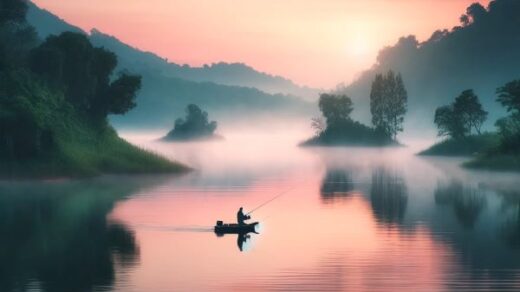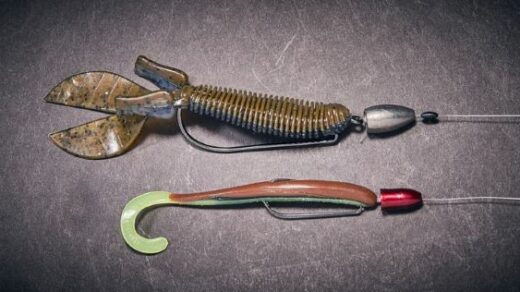Fishing enthusiasts often seek out innovative techniques to enhance their angling success, especially when casting from the shoreline. One such technique gaining popularity is the use of a drop shot rig, renowned for its versatility and effectiveness in various fishing scenarios. Whether you’re targeting finicky bass or elusive panfish, mastering the drop shot rig from the shore can significantly amplify your catch rates. In this guide, we’ll delve into the intricacies of fishing a drop shot rig from shore, exploring the setup, presentation techniques, and strategic considerations to elevate your fishing game to new heights. So, grab your gear and let’s uncover the secrets of shoreline drop shot fishing prowess.
Setting Up Your Drop Shot Rig for Shoreline Success
Before you cast your line from the shore, it’s crucial to ensure your drop shot rig is meticulously set up for optimal performance. This section will guide you through the step-by-step process of assembling your rig to maximize effectiveness.
- Selecting the Right Gear: The foundation of a successful drop shot rig begins with choosing the appropriate equipment. Opt for a sensitive spinning rod in the 6 to 7-foot range, paired with a high-quality reel spooled with light monofilament or fluorocarbon line in the 4 to 8-pound test range. A light line enhances sensitivity, crucial for detecting subtle strikes often encountered when drop shot fishing.
- Choosing the Perfect Hook: When it comes to hooks for drop shot fishing, opt for a size 1 or 1/0 hook, preferably with a thin wire and an offset design. This configuration allows for easy rigging of soft plastic baits while ensuring optimal hook penetration upon striking. Experiment with different hook styles to determine which one provides the best hook-up ratio based on your target species and fishing conditions.
- Rigging the Drop Shot: Begin by tying a Palomar knot to attach your hook to the main line, leaving a tag end of approximately 10 to 12 inches. Next, pinch a drop shot weight (typically 1/8 to 1/4 ounce) onto the tag end of the line, ensuring it sits a few inches above the hook. The distance between the weight and hook can vary based on water depth and the height of the vegetation you’re fishing around. Adjust this distance accordingly to maintain the desired presentation.
- Selecting Soft Plastic Baits: Soft plastic baits are the go-to choice for drop shot fishing due to their lifelike appearance and enticing action. Opt for slender finesse worms, small creature baits, or minnow imitations in natural colors to mimic the forage prevalent in your fishing area. Experiment with different bait styles and colors to determine which ones trigger the most strikes from your target species.
- Fine-Tuning Your Presentation: Once your rig is assembled, it’s time to focus on presentation. Cast your drop shot rig parallel to the shoreline, targeting structure such as rocky outcrops, submerged vegetation, or drop-offs where fish are likely to congregate. Allow the rig to sink slowly to the desired depth, maintaining slight tension on the line to detect any subtle bites. Experiment with varying retrieve speeds and subtle twitches to entice hesitant fish into striking.
Advanced Techniques for Working Your Drop Shot Rig
Now that you’ve mastered the setup of your drop shot rig from the shoreline, it’s time to delve into advanced techniques for effectively working your rig to tempt even the most stubborn fish. This section will explore nuanced approaches to presentation and retrieval that can make all the difference in maximizing your catch rates.
- Fine-Tuning Depth and Leader Length: One of the key advantages of drop shot fishing is its versatility in targeting fish at various depths. Experiment with adjusting the length of your leader line between the weight and hook to pinpoint the strike zone. Start with a leader length of around 12 to 18 inches and gradually adjust based on the water depth and the behavior of the fish. Keep track of your adjustments in a log to identify patterns and refine your approach over time.
- Utilizing Vertical Jigging Techniques: While drop shot rigs are commonly associated with a horizontal presentation, employing vertical jigging techniques can be highly effective, especially when fishing in deeper water or around vertical structures. Drop your rig straight down and use gentle lifts and drops of the rod tip to impart subtle action to the bait while maintaining contact with the bottom. This vertical presentation can trigger reaction strikes from fish holding tight to structure.
- Deadsticking for Finicky Fish: When fish are in a lethargic or negative feeding mood, employing a deadsticking technique can entice reluctant bites. After casting your drop shot rig, allow it to settle on the bottom without imparting any movement. The natural buoyancy of the soft plastic bait combined with occasional twitches of the rod tip can mimic the movements of injured prey, drawing strikes from opportunistic fish.
- Experimenting with Bait Dynamics: Beyond simply choosing the right soft plastic bait, experimenting with bait dynamics can yield impressive results. Try trimming or tailoring the shape of your bait to match the prevailing forage or mimic specific prey behaviors. Additionally, adding scent attractants or applying subtle dips and shakes to the bait can enhance its appeal, especially in situations where fish are hesitant to commit.
- Adapting to Changing Conditions: Successful drop shot fishing from the shoreline often requires adaptability in response to changing environmental conditions. Pay close attention to factors such as water clarity, temperature, and weather patterns, adjusting your presentation and bait selection accordingly. Keeping a log of successful techniques and observations can help you develop a repertoire of strategies for different fishing scenarios.
Refining Your Approach and Troubleshooting Common Challenges
As you continue to hone your skills in drop shot fishing from the shoreline, refining your approach and addressing common challenges will be essential for sustained success. This section will delve into strategies for fine-tuning your tactics and overcoming obstacles encountered during your fishing endeavors.
Fine-Tuning Your Tackle Selection:
| Challenge | Solution |
| Inconsistent Casting Distance | Adjust your rod and reel settings for optimal casting distance. |
| Line Twist and Tangling | Use a quality spinning reel with a smooth drag system and avoid overfilling the spool. |
| Snags and Hang-Ups | Opt for drop shot weights with a snag-resistant design and adjust your casting angle to avoid snag-prone areas. |
Adapting to Changing Conditions:
| Challenge | Solution |
| Fluctuating Water Levels | Monitor water levels and adjust your fishing location and presentation accordingly. |
| Altered Fish Behavior | Experiment with different baits, presentations, and retrieval speeds to entice reluctant fish. |
| Increased Angler Pressure | Explore less-frequented fishing spots and employ stealthy approaches to avoid spooking fish. |
Maintaining Patience and Persistence:
| Challenge | Solution |
| Frustration from Unsuccessful Trips | Embrace the learning process and view each outing as an opportunity to refine your skills and knowledge. |
| Dealing with Adverse Weather | Plan ahead by checking weather forecasts and dressing appropriately for comfort and safety. |
| Overcoming Fishing Plateaus | Seek advice from experienced anglers, experiment with new techniques, and maintain a positive attitude towards continuous improvement. |
Environmental Conservation and Ethics:
| Challenge | Solution |
| Minimizing Environmental Impact | Practice catch-and-release fishing, properly dispose of trash, and respect wildlife habitats to preserve natural ecosystems for future generations. |
| Ethical Angling Practices | Adhere to local fishing regulations, treat caught fish with care and respect, and prioritize the well-being of both fish populations and their habitats. |
Community Engagement and Knowledge Sharing:
| Challenge | Solution |
| Connecting with Fellow Anglers | Join online forums, attend local fishing events, and participate in community-based conservation initiatives to foster connections and share knowledge with like-minded individuals. |
| Promoting Sustainable Fishing Practices | Educate others about responsible angling practices and advocate for policies that promote the long-term health and sustainability of fish populations and aquatic ecosystems. |
Safety Measures and Environmental Awareness
As you delve deeper into the world of drop shot fishing from the shoreline, it’s essential to prioritize safety and environmental consciousness to ensure a fulfilling and sustainable angling experience. This section will outline crucial safety measures and environmental awareness practices to uphold while pursuing your fishing adventures.
Safety Equipment Checklist:
| Safety Equipment | Purpose |
| Personal Flotation Device (PFD) | Provides buoyancy and aids in flotation in case of accidental falls or slips into the water. |
| Protective Footwear | Offers traction and protection against sharp rocks, slippery surfaces, and potential hazards while navigating the shoreline. |
| First Aid Kit | Contains essential medical supplies to address minor injuries, cuts, or bruises sustained during fishing activities. |
| Sun Protection | Includes sunscreen, sunglasses, and protective clothing to shield against harmful UV rays and prevent sunburn and heat exhaustion. |
| Communication Device | Carries a charged mobile phone or two-way radio for emergency communication and contacting assistance if needed. |
Environmental Stewardship Practices:
| Stewardship Practice | Impact |
| Leave No Trace Principles | Adheres to principles of minimizing human impact on natural environments by packing out trash, avoiding damage to vegetation, and leaving the shoreline as pristine as you found it. |
| Responsible Bait Disposal | Properly disposes of unused bait, fishing line, and packaging materials to prevent wildlife entanglement and preserve aquatic ecosystems. |
| Habitat Preservation | Avoids disturbing sensitive habitats such as nesting areas, spawning grounds, and submerged vegetation to protect aquatic wildlife and maintain ecosystem balance. |
| Invasive Species Awareness | Educates oneself about local invasive species and takes measures to prevent their spread by properly disposing of unused bait and cleaning equipment before moving to different water bodies. |
| Water Conservation | Practices responsible water usage by minimizing runoff pollution, avoiding unnecessary water consumption, and supporting conservation efforts to preserve freshwater resources. |
Weather Awareness and Emergency Preparedness:
| Safety Consideration | Precaution |
| Lightning Safety | Seeks shelter immediately if lightning is observed and avoids open areas, tall trees, or bodies of water until the threat has passed. |
| Extreme Weather Preparedness | Monitors weather forecasts before fishing outings and prepares accordingly with appropriate clothing, shelter, and emergency supplies in case of unexpected weather changes. |
| Heat and Cold Stress Management | Stays hydrated, seeks shade during hot weather, and dresses in layers to prevent hypothermia and frostbite during cold weather conditions. |
| Navigation and GPS Awareness | Familiarizes oneself with the fishing location and carries a map, compass, or GPS device to navigate unfamiliar terrain and avoid getting lost. |
Target Species and Best Practices
Understanding the behavior and preferences of your target species is paramount when fishing with a drop shot rig from the shoreline. This section will highlight common freshwater species often pursued by anglers and the best practices for effectively targeting them using drop shot techniques.
Target Species Profile:
| Species | Habitat | Preferred Baits | Presentation Tips |
| Largemouth Bass | Lakes, ponds, rivers, and reservoirs | Finesse worms, creature baits, minnow imitations | Cast near structure and cover such as weed beds, submerged logs, and rocky outcrops. Vary retrieval speed and add occasional twitches to entice strikes. |
| Smallmouth Bass | Clear, rocky streams, rivers, and lakes | Small crayfish imitations, finesse worms, tube baits | Target rocky points, submerged ledges, and drop-offs. Use vertical jigging techniques in deeper water and focus on maintaining bottom contact. |
| Panfish (Bluegill, Crappie, Perch) | Shallow, weedy areas in ponds, lakes, and rivers | Small soft plastic grubs, tiny jigs, live bait such as worms or minnows | Present baits near vegetation edges, docks, and submerged brush. Use a slow, subtle retrieve to mimic natural prey movements. |
| Walleye | Large lakes, reservoirs, and rivers | Soft plastic minnow imitations, nightcrawlers, leeches | Fish near rocky points, submerged humps, and drop-offs during low-light periods. Experiment with different depths to locate feeding walleye. |
- Best Practices for Targeting Specific Species:
- Largemouth Bass: Focus on presenting your drop shot rig near their preferred ambush points, such as submerged vegetation, fallen trees, and rocky structure. Experiment with different bait sizes and colors to match the forage available in the area.
- Smallmouth Bass: Target rocky shorelines, submerged boulders, and deeper pools where smallmouth bass often congregate. Use finesse presentations and be prepared for aggressive strikes, especially during feeding periods.
- Panfish: Utilize light tackle and finesse baits to target panfish in shallow, weedy areas. Pay attention to subtle bites and adjust your presentation accordingly. Be patient, as panfish tend to school together, and catching one often leads to multiple hook-ups.
- Walleye: Fish during low-light conditions, such as dawn and dusk, when walleye are most active. Experiment with different depths and bait presentations to locate feeding walleye, and consider using live bait for added attraction.
- Conservation Considerations:
- Practice Catch-and-Release: Release undersized or non-target species carefully to ensure their survival and contribute to sustainable fisheries management.
- Handle Fish with Care: Minimize handling time and avoid injuring fish by using wet hands or a landing net when landing and releasing them.
- Respect Regulations: Familiarize yourself with local fishing regulations and adhere to catch limits, size restrictions, and seasonal closures to protect fish populations and their habitats.
Conclusion:
Mastering the art of drop shot fishing from the shoreline opens up a world of angling possibilities, providing both novice and experienced anglers with a versatile and effective technique for targeting a variety of freshwater species. Throughout this guide, we’ve explored the intricacies of setting up a drop shot rig, employing advanced techniques for presentation and retrieval, addressing common challenges, and prioritizing safety and environmental stewardship.
As you continue your journey into the realm of shoreline drop shot fishing, remember to approach each outing with patience, curiosity, and a deep respect for the natural world. Embrace the learning process, stay adaptable to changing conditions, and remain committed to conservation principles to ensure the long-term health and sustainability of our aquatic ecosystems.
Whether you’re pursuing trophy largemouth bass in a secluded pond, enticing panfish from a quiet riverbank, or outsmarting cunning walleye in a vast reservoir, the principles of drop shot fishing remain constant: attention to detail, strategic presentation, and a deep appreciation for the beauty and diversity of our freshwater habitats.
So, gather your gear, heed the lessons learned, and embark on your next shoreline adventure armed with newfound knowledge and a passion for the pursuit. With each cast, you’re not just angling for a catch – you’re forging a connection with nature and preserving the legacy of responsible angling for generations to come.




